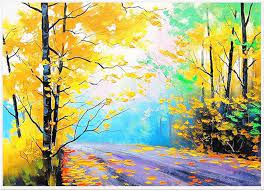The Vibrant World of Colourful Paintings
Colourful paintings have a unique way of captivating our senses and stirring our emotions. From bold, vivid hues to subtle pastel tones, artists use colour to convey a wide range of moods and messages in their work.
One of the most striking aspects of colourful paintings is their ability to evoke a sense of joy and energy. Bright colours such as reds, yellows, and oranges can create a feeling of warmth and vitality, drawing the viewer into the artwork’s world.
On the other hand, cool tones like blues, greens, and purples can instil a sense of calm and tranquillity. These colours are often used to evoke feelings of serenity and contemplation, inviting viewers to reflect on the artwork’s deeper meanings.
Colourful paintings also have the power to express complex emotions and themes. Artists may use contrasting colours to create tension and drama in their work, or harmonious palettes to convey a sense of unity and balance.
Whether it’s an abstract composition bursting with vibrant colours or a realistic landscape painted with subtle tonal variations, colourful paintings have a universal appeal that transcends language and culture.
Next time you find yourself in front of a colourful painting, take a moment to immerse yourself in its rich palette and let the colours speak to your soul. You may be surprised by the depth of emotion and meaning that can be conveyed through the simple act of painting with colour.
Exploring the Spectrum: Five Key Questions on the Role and Impact of Colour in Art
- What is the significance of using vibrant colours in paintings?
- How do artists choose the colour palette for their paintings?
- Can colourful paintings evoke different emotions in viewers?
- Are there cultural influences on the use of colour in art?
- What techniques can artists use to create depth and dimension with colours in paintings?
What is the significance of using vibrant colours in paintings?
The significance of using vibrant colours in paintings lies in their ability to evoke strong emotions, convey powerful messages, and create a lasting impact on the viewer. Vibrant colours have the power to energise a composition, drawing the eye and capturing attention. They can symbolise a wide range of emotions, from joy and excitement to passion and vitality. Artists often use vibrant colours to express their creativity, make bold statements, or evoke specific atmospheres within their work. By utilising a rich and diverse colour palette, artists can imbue their paintings with depth, complexity, and visual interest that resonates with viewers on a profound level.
How do artists choose the colour palette for their paintings?
Artists approach the selection of a colour palette for their paintings with careful consideration and intention. The choice of colours plays a crucial role in conveying the mood, tone, and message of a piece of art. Some artists draw inspiration from nature, using the vibrant hues found in landscapes or seascapes to inform their palette. Others may rely on personal experiences or emotions to guide their colour choices, creating paintings that reflect their innermost thoughts and feelings. Experimentation with different combinations of colours is also common practice, as artists seek to achieve the desired visual impact and evoke specific reactions from viewers. Ultimately, the process of choosing a colour palette is a deeply personal and creative decision that allows artists to infuse their work with depth and meaning.
Can colourful paintings evoke different emotions in viewers?
Colourful paintings have the remarkable ability to evoke a diverse range of emotions in viewers. The interplay of vibrant hues and subtle tones can elicit feelings of joy, energy, tranquillity, and contemplation, among many others. Artists strategically use colours to create emotional depth and impact in their work, with each shade carrying its own unique symbolism and significance. Whether through bold contrasts or harmonious palettes, colourful paintings possess a dynamic quality that resonates with individuals on a deeply personal level, making the viewing experience both enriching and emotionally engaging.
Are there cultural influences on the use of colour in art?
The use of colour in art is deeply intertwined with cultural influences, shaping the way artists express themselves and communicate meaning through their work. Across different societies and historical periods, colours have held symbolic significance and cultural connotations that impact artistic expression. For example, vibrant reds may symbolise luck and prosperity in some cultures, while representing danger or passion in others. Similarly, the use of specific colours in religious or ceremonial contexts can carry profound cultural meanings that enrich the visual storytelling of artworks. By exploring the cultural influences on the use of colour in art, we gain a deeper appreciation for the diversity and richness of artistic traditions around the world.
What techniques can artists use to create depth and dimension with colours in paintings?
Artists have a myriad of techniques at their disposal to infuse depth and dimension into their colourful paintings. One common method is the use of colour contrast, where artists juxtapose complementary or contrasting hues to create visual interest and a sense of spatial depth. By carefully layering translucent washes of colour, artists can also achieve a sense of luminosity and transparency, adding richness and complexity to their work. Additionally, employing techniques such as colour blending, shading, and highlighting can help artists create the illusion of three-dimensional forms on a two-dimensional canvas. Through skilful manipulation of colour values and intensities, artists can masterfully bring their paintings to life with depth and dimension that captivate the viewer’s imagination.

